Preparing Trees for a Harsh Winter: Essential Tips for Winter Tree Care
As the winter season approaches, it is crucial to adequately prepare our trees to withstand the challenging conditions. Just like any living organism, trees need to be in good physical condition to survive adverse circumstances, whether they are humans or plants. In this article, we will discuss some general guidelines for preparing trees for an intense and difficult winter.
Rule #1: Avoid Pruning Trees in Autumn
The first important rule to follow is to refrain from pruning trees during the autumn season. Pruning during this time can be detrimental to trees as it can cause stress and weaken their overall health. During autumn, trees start storing energy and nutrients to sustain themselves throughout the winter. Pruning disrupts this process, leading to a depletion of their resources.
Rule #2: Cease Nitrogen Fertilization in Summer
It is crucial to stop nitrogen fertilization in the summer, before the onset of winter. Nitrogen is responsible for promoting tree growth, and applying it in the summer may encourage late-season growth that is vulnerable to winter damage. By discontinuing nitrogen fertilization, trees can naturally transition into a dormant state, focusing on conserving energy and strengthening their defense mechanisms against harsh winter conditions.
Rule #3: Avoid Ground Cultivation Near Trees
When it comes to maintaining the soil around trees, it is advisable to refrain from cultivating the ground in close proximity to them. Cultivating the soil disrupts the tree’s root structure and can cause damage. It is important to remember that the roots of trees extend beyond their canopy, and tilling or cultivating the soil within this area can harm the delicate root system. Instead, consider applying a layer of mulch around the base of the tree to retain moisture and regulate temperature.
Rule #4: Implement a Winter Protection Program
To safeguard trees from the harsh winter weather, it is essential to have a winter protection program in place. This program involves applying appropriate winter protection products to minimize damage caused by freezing temperatures, ice, and snow. One effective method is using biostimulant solutions that enhance the tree’s ability to withstand extreme conditions. Biostimulants contain natural compounds that promote growth, increase stress resistance, and foster a healthy root system.
Identifying the Ideal Winter Protection Product
Finding the right winter protection product can be a daunting task. However, there are various options available, and it ultimately depends on the type of trees and the specific requirements of your region. If you are unsure about which product to choose, do not hesitate to seek advice from tree care professionals or arborists. They possess extensive knowledge and experience in tree care and can provide recommendations based on your unique circumstances.
How to Choose the Right Winter Protection Product?
When considering winter protection products, it is essential to keep the following factors in mind:
- Species of Trees: Different tree species have distinct tolerances to winter conditions. Some trees are naturally more resistant to cold temperatures and do not require extensive protection, while others may be more susceptible to winter damage. Reflect on the characteristics of your specific tree species to determine the level of protection needed.
- Local Climate: Understanding the climate of your local area is crucial in selecting the right winter protection product. Regions with harsher winters might require more robust solutions, while milder climates may necessitate less intensive protection. Consider the average winter temperatures, snowfall, and freezing patterns in your area when making a decision.
- Tree Age and Health: The age and health of the trees also play a vital role in determining the appropriate winter protection. Younger trees and those with compromised health are usually more vulnerable to winter damage. In such cases, providing extra protection is imperative to ensure their survival.
- Environmental Impact: It is essential to select winter protection products that have a minimal environmental impact. Look for products that are eco-friendly and biodegradable, as they are less likely to harm the surrounding ecosystem.
In conclusion, preparing trees for a harsh winter is of utmost importance to ensure their survival and well-being. By following proper winter tree care guidelines, such as avoiding autumn pruning, ceasing nitrogen fertilization in summer, and implementing a winter protection program, trees can become more resilient to extreme weather conditions. Additionally, selecting the right winter protection product that suits the tree species, local climate, tree age, and health is crucial in safeguarding trees from winter damage. Remember, seeking advice from tree care professionals can provide valuable insights and guidance in making informed decisions. So, let’s embark on the journey of preparing our trees for the upcoming winter and provide them with the care they need to thrive.






